General
1) Does the electric bike vibrate like a gasoline-powered bike?
No, it does not. The first thing riders notice is the silence and the lack of vibration (followed by the low center of gravity or balance point). You can see in the mirrors as they are not shaking and your hands do not become numb from vibration.
2) Do the bikes make any noise?
The bike is almost silent. Hard throttle applications produce a low growl for a short distance off the line. After this, the bike is mostly silent except for the sound of the tires on the pavement and the sound of the electric motor soft whiring.
You do not hear the sound of the chain and belt drives like on in chassis motor electric bikes such as nor the high rpm sound of their motors. The hub motors on our bikes turn 80% less rpm than comparable in chassis motors at the same vehicle speeds, so they are far less noisy and much more durable (and require no maintenance) At a stop the bike is completely silent. Freely talk to your friends at the stoplight.
3) How much less expensive is it to run electricity instead of gasoline?
Understanding the cost comparison of an electric vehicle can be complicated and goes beyond simply how much gas will I save. It has a lot to do with your driving habits and the different vehicles you are comparing. How often you drive, how far you drive, and how many years you intend to keep your vehicle all account for your savings.
To get a true grip on the big advantage in the life cycle of electric, consider a comparison between a little 250 cc maxi scooter and the most expensive and longest range ZEV that has the most expensive battery pack to replace of all of the ZEV bikes.
For the ZEV, with zero moving parts in the motor, there is no real reason for the motor to fail in anything near the time before a top end overhaul of a gasoline bike is required. ZEV motors are expected to reach 100,000 miles. They have accumulated as much as 50,000 miles with zero performance decrease running like new. But assuming that the motor did fail, a new motor is a 4 bolt drop in unit that costs $750. If you consider the battery replacement as the equivalent of replacing or overhauling the engine in your maxi scooter, the cost would be $2,400 or more. The battery swap seems to be needed about every 15,000 to 20,000 miles depending on the riders charging habits and cost on average $180 in shop labor to install. Keep in mind that your regular scooter will also need a new battery every 2 years on average also (at least 4 times in 20,000 m). Another $400 of cost minimum for the gas bike.
The gas maxi scooter will require a full rebuild once in 20,000 miles in general (although some people do much better). Many brands are requiring top end overhauls by 10,000 miles, and then the full overhaul at 20,000 miles. It’s a major tear down and time consuming operation to overhaul the engine, and most people have to take it to a specialist. That is just the engine.
Consider the state of rust and damage on the exhaust system. Most will not make it to 20,000 miles. Add $400 to $1500 to the repair bill just for exhaust issues of replacement parts and labor.
Now add lots of oil changes, filter changes, valve adjustments, drive belt changes and adjustments, trips to and from the dealer for service, and the gasoline begins to look terrible in comparison. A basic service trip to the shop for the gasoline bike will cost on average about $150 and these trips will occur in general every 1,200 miles cost approximately $3000 during the 20,000 miles (20 trips). (Some riders change oil and filters every 500 miles which doubles the cost) The engine overhaul top end will cost approximately $1,000 to $3000 in parts and labor. In the case of a BMW motor scooter, a valve adjustment, oil and filter change at our local shop is over $1,000. You will need several of those to reach 20,000 miles.
Now factor in fuel costs. Lets use high speed Interstate driving to maximize fuel consumption. A ZEV driven hard daily on the Interstate for 60 miles per day uses 6 kwh or 100 kw/m. Average electrical rate of 12 cents per kwh in the USA. In West Virginia, and Western Pa it is only 5.7 cents per kwh so many states are much lower than 12 cents. At 12 cents/kwh -to drive 20,000 miles uses 2,000,000 kw or $240 of electricity. The Maxi gas scooter driven at 70 mph for 60 miles will burn fuel at approximately 45 mpg or 1.3 gal of gasoline. Even at today’s lower prices, that is $5 of gasoline or $1,660 in gasoline over 20,000 miles. $1,400 more “fuel” cost than the electric.
The ZEV and a brand name maxi scooter are in the same price range. The brakes and tires they consume will be nearly identical. Depreciation, and consumable usage will be nearly identical.
COST ITEM ------------------------------------------------------------------------------------------------ ZEV ---------- MAXI SCOOTER
Exhaust replacement including labor ------------------------------------------------------------------- $0 --------------- $400 - $1200
Regular Engine Maintenance service ------------------------------------------------------------------- $0 ------------ $3,000 - $4,000
Battery Replacement ------------------------------------------------------------------------------------- $2,580 ------------ $400 -$800
Top end overhaul ----------------------------------------------------------------------------------------- $0 ----------------------- $3,000
Full engine Overhaul ------------------------------------------------------------------------------------- $0 ------------- $3,000 - $5,000
Total power plant costs in 20,000 miles --------------------------------------------------------------- $2,500 ------------------ $9,800
Fuel costs ------------------------------------------------------------------------------------------------ $240 --------------------- $1660
TOTAL 20,000 mile cost -------------------------------------------------------------------------------- $2,740 ------------------ $6,880
When all costs are considered, The ZEV will cost about 12 cents a mile to run 20,000 miles (exclusive of “fuel”). The gas maxi scooter will cost 33 cents per mile for the same distance.
ZEV customers tell ZEV there are hidden costs in the gasoline scooter ownership, the cost of the time to stop and buy gasoline, and service related time. A typical very large scooter with the largest fuel tank holds 4 gallons. So the rider must stop for fuel at least every 3 days. Even if it is only 15 minutes each time to fuel, that is 111 trips to the gas station and a 28 hours of time spent at the gas station. But the time issue most ZEV riders talk about when discussing their old gas scooter is the trip to the service shop every 500 to 1,000 miles which requires a two way drive and someone else with a vehicle to take them two and from twice. That is two people at an average reported of 1 hour to drive and go in the shop 20 times. Forty man-hours. Considering that it only takes about 1.5 years to accumulate 20,000 miles at this rate and you are spending 45 man-hours a year (68 man-hours in 1.5 years) taking care of your scooter. As one ZEV customer stated, “It is like getting a week of extra vacation every year”.
If you have any further questions just give us a call, this is an issue that we are always happy to discuss and it is of course a primary concern before you buy a vehicle.
5) How hard is the bike to drive?
Easier than a conventional motorcycle. All of the controls are hand controls and their is no clutch. Additionally the very low center of gravity, created by the having the hub motor and batteries below the axle line, makes the bikes easy to handle in parking lots. The seat height is much lower than most motorcycles.
With all hand controls on the scooter (motor cyles by law need a foot rear brake), coupled with the 4 to 8 inch lower seat height (compared to motorcycles) the bike is extremely easy to use by a wider range of people including those of slight build, shorter inseams, or any lower disability.

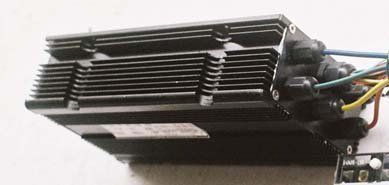
5) Explain the problem of corrosion in all aluminum motors and how your oil bath stops this?
Many motors have cast aluminum housings. The metal is not treated for corrosion. So after a short time they look like this photo below.
This white coating that forms from corrosion on the aluminum parts is just part of the problem. A rust also forms on the magnets. As the clearance in the motor is usually 1 mm or less, the motor becomes a grinder for the small particles of rust and aluminum oxide dragging down the motor. The white aluminum oxide coating acts as a heat barrier causing motors to run hotter. Hot motors do not last as long as cooler ones and put out less power.
ZEV motor parts are treated to stop this corrosion and the heat problems that go with it. The oil bath in our hub motors keeps the parts coated in oil so that corrosion does not occur while cooling and lubricating the parts.
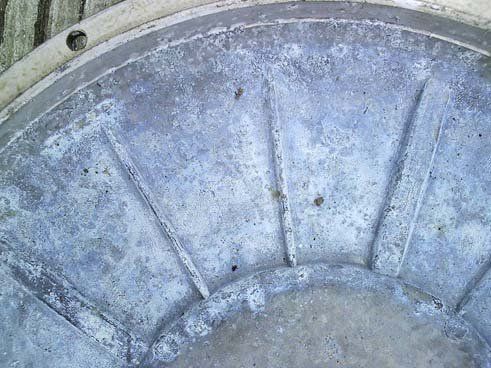
6) Is getting water on the electric hub motor or controller a big worry? Will it short out?
ZEV models use a sealed hub motor and controller. Our products have a double seal at the axle and a seal around the motor housing, so riding in the rain or on a rain soaked street is not a problem.
However, ZEV are not off road bikes meant to be used for running through the mud or into salt water. Driving the bike into water that is deep enough to flow into the front air inlet or sides and wash over the battery terminals will possibly cause damage.
Batteries
7) How long does it take to charge a ZEV bike battery?
A lithium battery ZEV can absorb about a 75% charge in only about 25 minutes. Generally, two hours of normal charger usage is required to top off the battery. Four hours of charging is required if the battery is depleted. (Batteries should not be used to total depletion, otherwise damage can occur.)
ZEV battery are mated with the chargers so that it takes an 4.5 hours to charge the bike, regardless of model up to 10 kwh of battery capacity on 110 volt. Charging on 220 decreases the charging time somewhat.
The best battery life can be obtained by charging after every use. Running the battery to depletion and then charging shortens its life. Charging at 70-75% depletion instead of 80% depletion increases the battery life by 50% according to the battery supplier. Lithium and lead acid batteries can be charged whenever possible regardless of the charge left.
Charging with a 220 v charger takes on average 2/3 the time than with a 120 volt charger. Installing a 220 volt outlet and ordering a 220 v charger will give you far shorter charging periods.
9) How do you know when you need to charge the battery?
On every ZEV there is a battery power meter on the instrument panel. This meter reads acts like your fuel gauge. The instrument panel also features a volt meter informing you of the total voltage available to the motor as it declines during a long ride.
To further warn that you are running low on power, there is a speed step-down feature in the controller. Once the voltage is significantly depleted, the internal computer steps down the power to limit the maximum speed, thereby providing a gentle reminder to start thinking about a recharge.
Your ZEV should also be charged monthly even when not being driven.
10) What brands of battery do you use and why?
We use two types of battery, GBSystems Lithium and the GreenSaver silicone battery. (The GreenSaver battery is unique among lead based battery in that it is not acid, it is alkaline. It does not sulfate and go bad like an acid battery. It also maintains its power at sub-zero temperatures.) While there are many other brands on the market, these two are the best to use for several primary reasons. These batteries are the most proven and widely-used batteries in electric bikes in the world. Because of the huge number of vehicles that use these batteries, the battery sizing has become standard so other companies have conformed to fit this standard.
Unlike companies that use 190+ tiny batteries linked together or use a unique battery pack, there will be a supply available when you finally need a battery replacement. Even in the apocalyptic scenario that ZEV is not able to supply our customers with replacement battery packs, the customer will be able to procure new batteries for themselves. You do not even need to buy it from ZEV.
11) How long do the lithium batteries last?
According to the manufacturer, the batteries will last for over 3000 full cycles in general usage. The less depleted a battery is when it is charged, the more cycles will be obtained. In daily use, a battery is generally not run down to near depletion, so the cycle life is high.
We use the GBSystems battery in our lithium models with a Battery Management System (BMS) that mounts on top of each battery to protect the entire battery pack. This photo shows the 4 bolt per terminal connection featured on all our models that offers radically more protection from connection loosening over normal 1 bolt per terminal battery connections.
In some of our vehicles starting in 2024, we are using the CATL battery which have over 10,000 full cycles in general use.
12) Do you have trouble with battery cooling or battery fires?
We have never had a battery fire.
We do not have hot battery problems because of our emphasis on cooling all parts of the system. To prevent any battery problems due to heat we use batteries that are in finned cases for heat shedding. These fins additionally prevent the batteries from fitting against each other creating cooling passages between the batteries that align with cooling passages in the battery mounting tray. We do not build our battery into separate sealed metal canisters where heat is a concern.
Handling, Storage, & Frame
13) How is it possible that you get the claimed handling out of scooter-sized wheels compared to a motorcycle?
First of all, there is little difference in the diameter of the tire mounted on the wheel. Many motorcycles run 16 inch wheels. Racing-type bikes like the Honda CBR600RR or the Kawasaki ZX10 run 17 inch wheels. However, the diameter gets you no advantage. Consider that 17 inch wheels are used on 140-160 mph motorcycles: larger OD wheels run less rpm for a given speed. That makes the forces on the tire less at blinding speeds. Our tire OD is in keeping with our max design speed for our scooter line of 110 mph.
The big difference is in the tire cross section on the road. A Honda CBR600RR sport bike runs a 120/70 front tire. Our ZEV bikes run a 130/60. Our scooter tire is wider than the sport bike tire for more tire contact with the road and has a shorter, stiffer sidewall for less tire squirm in the turns and during hard braking. For hard braking or hard down in a curve, the tire contact patch size is the big factor along with how much grip and force can the tire transfer to the road. Just how big and fat our tire is can best be realized in this photo.
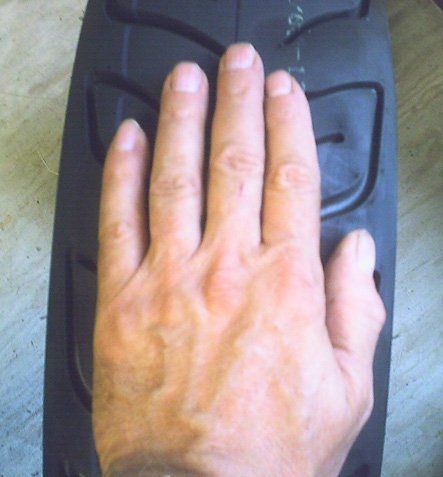
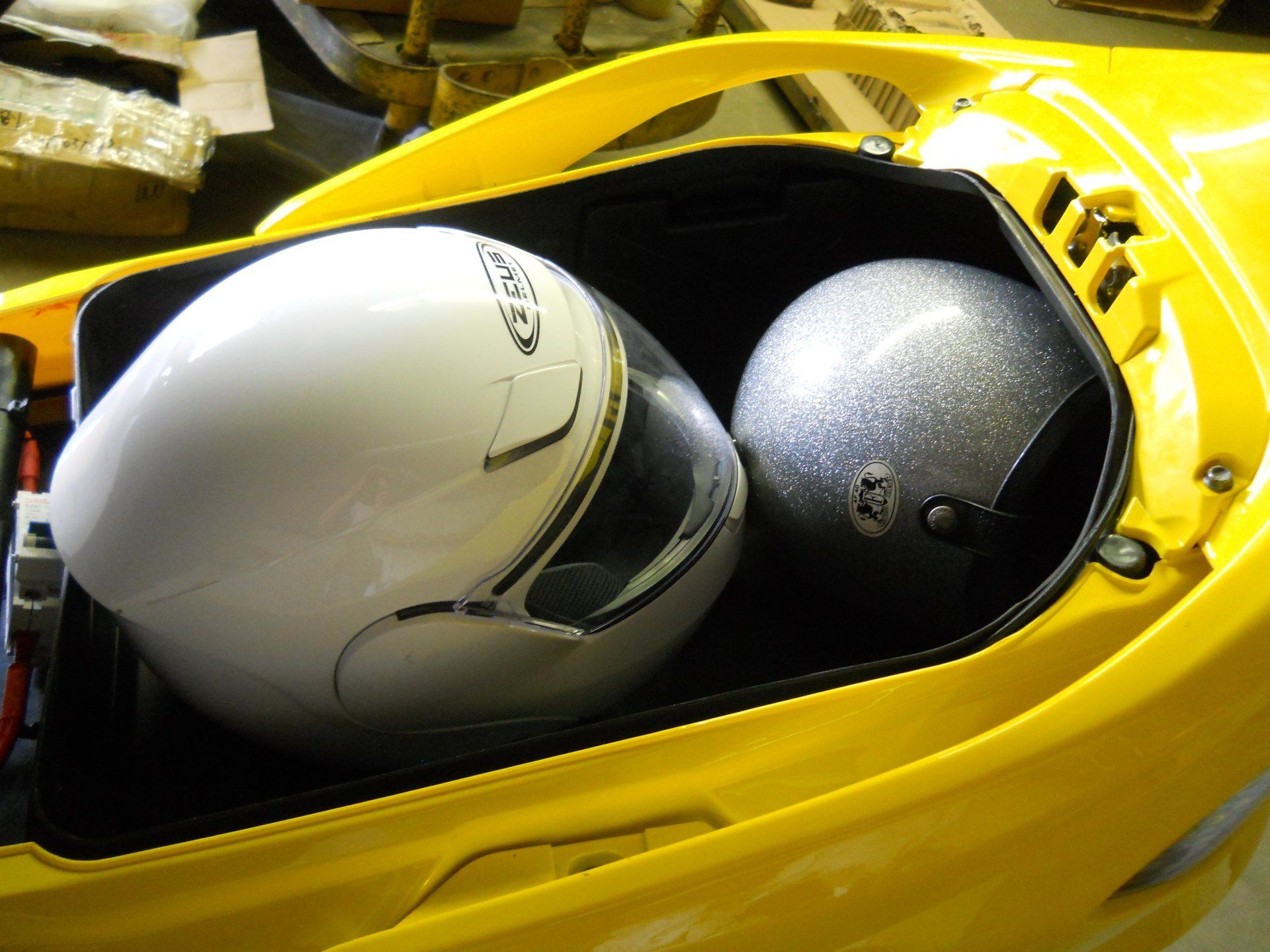
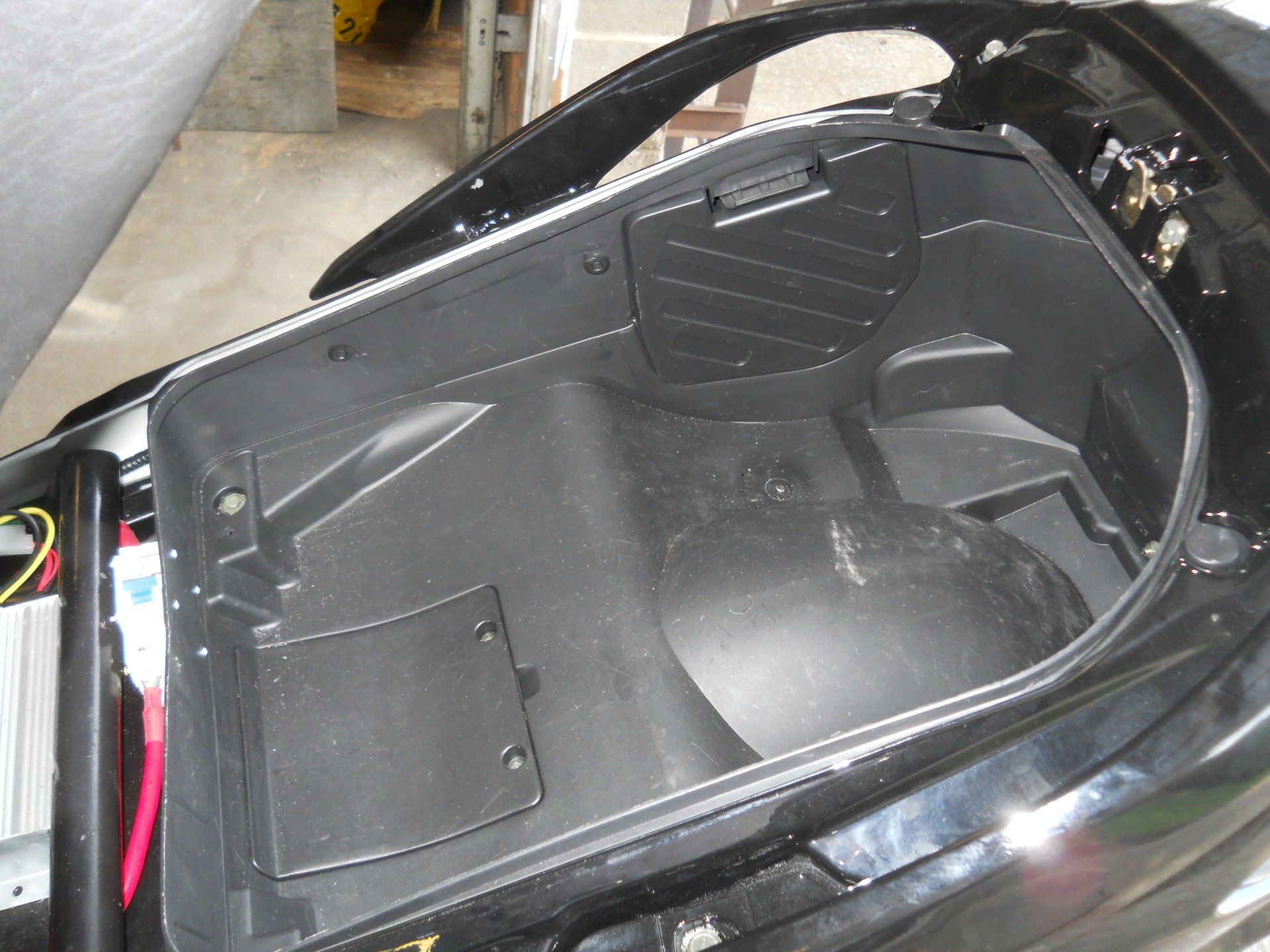


- A label showing verifying that it is NHTSA compliant. This label must match a specific configuration required by law.
- A label showing that it meets all EPA requirements.
- Look for the plastic covers on the swingarm or the plastic fake exhaust. Absolute Chinese giveaway.
- Ask the company to show you their models for 7,000, 8000, or 10,000 watts of motor output power or to see a 72 volt bike with 60 Ah battery installation of 5 Kwh capacity. Their frames are not the same as our special frames and cannot hold the battery volume.
- Ask the company to show you their oil bath motor.
- Ask if they have a daylight-running headlight that complies with USA law. We know of no made in China bike that is legal to drive because it does not have this on light.
- Ask to see the EPA and DOT compliance labels with the stamped in VIN number that must be on the bikes to be legally sold in the USA.
- Ask if they have a 3 or 4 speed electronic transmission controller. Only ZEV has this.
- Ask to see their 70, 80, or 90 mph bikes. Only ZEV has these.
- Look at the brakes. Do they have dual piston calipers on front and the rear?
- Do they have the large OD front disk for more swept area like the ZEV?
- Is the luggage rack black like all ZEV? Chinese bikes tend to have silver luggage racks.
- Do they have the 100 mph speedometer of the ZEV?
- Request a copy of their Manufacturer's Certificate of Origin. If it does not have the manufacturer as Z Electric Vehicle on it, then it is a fake.
- Ask for what the VIN number is on the bike you want to buy. If it does not say 1Z9, it is not ours. If it says L or X as the first number, it is clearly made in China.
- Look at the motor to see if it is the very high bolt count, black, modular motor, with cooling fins like our motors.
